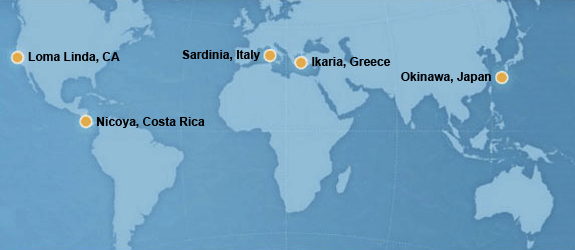In 2009, National Geographic Fellow Dan Buettner published findings from his quest to find the world’s longest-lived, healthiest human beings and identify common threads that unite them. Dubbed the Blue Zones®, he found these exemplary communities in California (a Seventh Day Adventist community), Costa Rica, Greece, Sardinia, and Japan.
In The Blue Zones: Lessons for Living Longer from the People Who’ve Lived the Longest, he shares nine secrets to their success:
- Sustained movement through acts of daily living – walking, preparing meals using whole foods, doing chores, gardening
- Purpose – a reason outside of work that makes life worth living
- Daily routines through which they relax and relieve stress
- Leisurely meals during which they eat to ~80% capacity (leaving ample room for digestion)
- One or two glasses of wine daily with good friends
- Primarily plant-based diets with small, intermittent servings of meat, poultry, and fish
- Social circles that encourage and reinforce their healthy behaviors
- Participation in faith-based communities
- Focus on family as witnessed by committed marriages, attentive parenting, care and concern for the elderly
Unlike the average American, these folks do not obsess over the latest health fad. They don’t count calories or worry about the optimal ratio of protein, carbohydrates, and fats. They simply live the way their parents and parents’ parents lived without the specter of heart disease, obesity, cancer, diabetes, and dementia looming in their advanced years.
In The Blue Zones Solution: Eating and Living Like the World’s Healthiest People, Buettner takes a closer look at food choices in the 5 communities. While the composition of their diets vary according to tradition and available raw materials, all 5 communities place little emphasis on fish, meat, poultry, and eggs. Here are their average daily intakes by food group:
| CA | CR | GR | IT | JP | |
| Vegetables | 33% | 14% | 46% | 12% | 32% |
| Fruits | 27% | 9% | 16% | 1% | – |
| Legumes | 12% | 7% | 11% | 4% | 16% |
| Grains, Rice, Pasta | 7% | 26% | 6% | 47% | 23% |
| Fish, Meat, Poultry, Eggs | 6% | 7% | 11% | 5% | 15% |
| Dairy (e.g., goat’s milk) | 10% | 24% | – | 26% | 8% |
| Oils | 2% | 2% | 6% | 2% | – |
| Sweets | 1% | 11% | 4% | 3% | – |
| Other | 2% | – | – | – | 6% |
Based on his research, Buettner suggests the following practices:
- Make your first meal of the day the largest, lunch the second largest, and dinner the smallest; add one light snack, as needed.
- Cook at home using fresh, high quality ingredients (e.g., organic produce, free range poultry, grass fed meats).
- Don’t eat while standing, driving, watching TV, reading, or using electronic devices. Rather, invite family and friends to dine with you.
- Stop eating when you are 80% full. Either pre-plate the food, or eat slowly enough that the body can register its food consumption and signal when full.
- Make meal time a celebration!
He also recommends food choices for longevity. Based on his experience and a confluence of nutritional research, 95% of the diet should come from a whole plant. Meat, poultry, and fish should make occasional appearances in small portions – i.e., servings roughly the size of a deck of cards. Eat at least one-half cup beans daily as they’re high in protein and fiber. Minimize dairy as we don’t digest it well (although fermented goat’s milk seems to be OK). Replace common bread with sourdough or whole wheat. Snack on nuts. Slash sugar.
Note: Blue Zones® is a registered trademark of Blue Zones, LLC. Blue Zones is dedicated to creating healthy communities across the United States. Visit their website at https://bluezones.com/.
